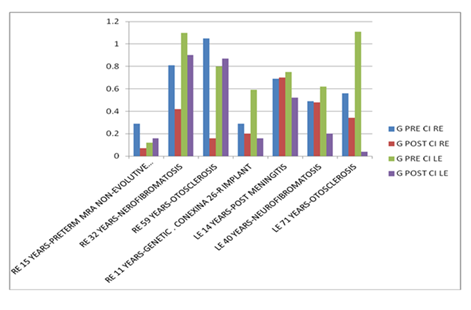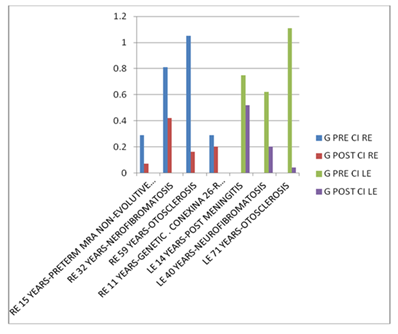Journal of
eISSN: 2379-6359


There is no doubt that cochlear implant (CI) has been the most important contribution made by otologic surgery to the disabilities caused by profound hearing loss, both in children and in adults. 66 adult and pediatric patients were studied. The possible cause of deafness was obtained, and a Video Head Impulse Test was performed to all of them. In a large group of patients with profound bilateral deafness of different etiologies, the vestibular function before the implant was not significantly affected except in 10,6% of the cases. In most patients, the cochlear implant did not significantly modify the VOR function. In the group of patients who previously had a damaged or asymmetric vestibular function, if the best ear is implanted, this could cause a bilateral vestibular failure, so that the ear with the lowest gain should be chosen to be implanted. The implant, when performed by experienced professionals, does not affect vestibular function, except in those cases where it is already damaged or asymmetric.
Keywords: vestibular function, cochlear implant, vHIT, Hearing Loss
There is no doubt that the cochlear implant has been the most important contribution made by Otological surgery to the disabilities caused by a profound hearing loss, both in children and adults.1,2
Unfortunately, it can also cause structural damage to the vestibular receptors of the implanted ear, as confirmed by histopathological studies3 and studies using clinical tests such as: video head impulse test (vHIT)4 and vestibular evoked myogenic potentials (VEMP).5
Different mechanisms that could lead to vestibular dysfunction during or after CI surgery have been postulated: 1) direct trauma caused by the insertion of the electrode, 2) acute serous labyrinthitis due to cochleostomy, 3) reaction of the foreign body with labyrinthitis, 4) endolymphatic dropsy and 5) electrical stimulation of the implant itself.6
It is necessary to recognize that many of the pathologies that produce deafness can alter vestibular function; therefore, patients who have auditory deficits are likely to suffer alterations in vestibular function prior to surgery.7,8
We carried out a retrospective study to know the effect of CI on vestibular function in children and adult candidates for cochlear implantation. 66 adult and pediatric patients were studied, taking into consideration the cut-off age in years.
All the patients underwent a surgery which was performed using the same technique and at the same center, between December 2013 and June 2015.
Video Head Impulse Test was performed to all of them which proved not only the efficacy but also the feasibility of being performed both in adults with comprehension limitations as well as in children,9 before the implant and one month after it. Due to the type of patients, it was decided to evaluate only the horizontal semicircular canals.
Video head impulse test in the evaluation (ICS Impulse) provided by Otometrics for special use in children. This test is based on vestibulo-ocular reflex.
This consists of a compensation of the head movements by the extraocular muscles, in which the vision remains fixed on an object, despite rapid head movements.
The patient is asked to fix his or her eyes on a target while rapid horizontal low-amplitude head movements are generated (to evaluate the horizontal canals) at an angle of approximately 15° randomly to the right and left, thereby stimulating the function of the horizontal semicircular canal on the side towards which the movement is performed. At the same time, the stimulated vestibular system activates the extraocular muscles in both eyes (the medial rectus in the ipsilateral eye and lateral rectus in the contralateral eye, thereby inhibiting the antagonist muscles) to contract them in a direct proportion to the head turn, and both eyes move to compensate and keep the vision fixed on the object.
In a patient with vestibular dysfunction, this reflex is altered and diminished. As the vestibular system is not stimulated, there is no excitatory signal to the extraocular muscles, which remain still in relation to the head while the gaze moves away from the object it was fixed on.
The results are expressed in Gain Value (Eye displacement/Head displacement) where the normal value is 1 and the tolerated asymmetry is 8%.
Table 1 shows the demographic data. The causes of deafness are shown in Table 2.
There was no significant reduction in VOR gain in patients with profound deafness, regardless of mechanism and age. In most patients, the implant did not result in any meaningful change in VOR function.
In those patients who had a reduced VOR function (10,6%), the implant in the better ear resulted in a meaningful reduction of this function with the corresponding posterior ataxia. There were no changes in the contralateral ear see Figure 1 & Figure 2. The etiologies in these cases were: genetic, neurofibromatosis, otosclerosis, post-meningitis and prematurity. The surgical technique used was in four cases per round window and in 3 cases by cochleostomy

Figure 1 The figure shows the pre- and post-surgery VOR gains of both ears in patients who had falls in their VOR gains.

Figure 2 The figure shows the pre and post surgery VOR gains only of the implanted ear that showed falls in their VOR gains.
Number of patients |
66 |
Age (year / ±DS) |
28,7 / ± 22,3 |
Female % |
48,5 |
Children and adolescents (N° / %) |
27 / 40,9 |
Table 1 Demographics
Etiology |
N° of patients |
Wide vestibular aqueduct |
2 |
Perinatal Anoxia |
1 |
Autoimmune |
3 |
Congenital |
5 |
Unknown |
15 |
Genetic |
6 |
Progressive hearing loss |
8 |
Rapidly progressive hearing loss |
1 |
Sudden hearing loss |
1 |
Mondini – no have CSE |
1 |
Neurofibromatosis |
2 |
Otosclerosis |
4 |
Ototoxics |
1 |
Incomplete partition |
1 |
Post-meningitis |
7 |
Post-surgery EV |
1 |
Prematurity |
6 |
Acoustic trauma |
1 |
Table 2 Etiology
In cases where hearing aids are no longer useful or sufficient, cochlear implant surgery (CI) is the standard procedure for the treatment of hearing loss. The CI attempts to replace the function of hair cells that can no longer stimulate primary auditory neurons in response to sound. Although the effects of CI surgery on residual cochlear function are well studied, less attention has been paid to its effects on vestibular function. Such effects occur because CI surgery frequently affects the vestibular apparatus, which is in close anatomical proximity to the auditory system.10
There have been some studies that evaluated vestibular function in cochlear implant surgery, their findings have been contradictory, and some have found that surgery can affect function while others do not. This may be due to the way of evaluating vestibular function (through objective vs. subjective methods).
Krause et al. evaluated the influence of the CI, depending on the peripheral vestibular receptor, on the implanted side, to examine a possible correlation with symptoms such as dizziness. The CI represented a significant risk factor for horizontal semicircular canal dysfunction (p <0.001) and saccular insufficiency (p = 0.047) in the implanted ear. There was no correlation between vestibular function and the presence of dizziness. The vestibular function of the contralateral side remained unchanged (p> 0.05).11
In another study, where the evaluation was performed using the dizziness handicap inventory (DHI), vestibuloocular reflex test (VOR) using alternating bithermal caloric irrigations (ENG) and sinusoidal harmonic accelerations (SHA) generated by rotational chair and platform posturography computerized dynamics (CDP), found that unilateral CI rarely produces significant adverse effects on the vestibular system, on the contrary, patients who underwent CI experienced significant improvements in the objective measures of postural stability measured by CDP.12
In a study conducted comparing two techniques used to insert the electrodes into the cochlea (standard cochleostomy and round window approach), he reported that the insertion approach does not seem to influence vestibular function. Most patients already had vestibular dysfunction before surgery, and there was no balance alteration after CI surgery.13
Batuecas Caletrio et al.,4 carried out a prospective descriptive study, where they evaluated the vestibular function before and after the CI surgery. Their findings show that, although CI is a safe surgery with few major complications, it is a procedure that can cause dizziness. The vHIT revealed that 30% of patients show a postoperative change in vestibular function.
Hviid Korsager et al.,14 carried out a prospective, double-blind, randomized study with the aim of establishing whether the round-window approach leads to less vestibular dysfunction and dizziness than the standard cochleostomy approach during cochlear implant surgery (CI), according to the evaluation through vHIT. In addition, the objective findings were compared with the subjective dizziness perceived by the patient. They did not find statistically significant differences between the cochleostomy approach and the round window approach using the vHIT and subjective dizziness perceived by the patient.
A recent meta-analysis found that CI surgery has a significant negative effect on the results of caloric tests and VEMP. No significant effect of CI surgery on HIT, posturography or DHI was detected. In general, the clinical effect of CI surgery on vestibular function was insignificant. However, the possible effects of surgery on the vestibular system should be discussed with CI candidates before surgery. One problem with this study is that he did not use the vHIT to evaluate the function of the semicircular canals, so the absence of effect on the HIT is only from the clinical point of view.15-17
We find that the implant, when performed by experienced professionals, does not affect vestibular function, except in those cases where it is already damaged or asymmetric; we did not find etiologic nor age coincidences in this group; it is clear that a decision must be made as to implant the worst ear so as to avoid a reduction in VOR function which leads to a bilateral vestibular failure with the corresponding disability caused by ataxia and oscillopsia.
As we have previously informed, the vHIT showed a clear interindividual reproducibility, thus proving itself a solid method for the evaluation of VOR function in any age group, and with no differences as to the etiology of the different cases.
In a large group of patients with profound bilateral deafness of different etiologies, the vestibular function before the implant was not significantly affected except in 10,6% of the cases. In most patients, the CI did not significantly modify the VOR function.
In this group of patients, if the best ear is implanted, this will result in a bilateral vestibular failure, so the ear with the lowest Gain should be chosen to be implanted.
None.
The author declares there is no conflict of interest.

© . This is an open access article distributed under the terms of the, which permits unrestricted use, distribution, and build upon your work non-commercially.